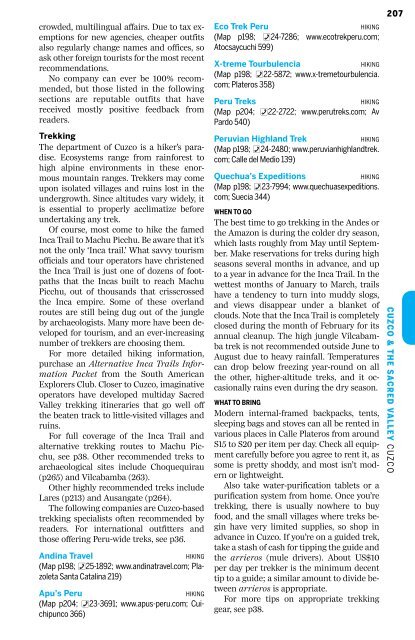peru-8-cuzco-sacred-valley
You also want an ePaper? Increase the reach of your titles
YUMPU automatically turns print PDFs into web optimized ePapers that Google loves.
crowded, multilingual affairs. Due to tax exemptions<br />
for new agencies, cheaper outfits<br />
also regularly change names and offices, so<br />
ask other foreign tourists for the most recent<br />
recommendations.<br />
No company can ever be 100% recommended,<br />
but those listed in the following<br />
sections are reputable outfits that have<br />
received mostly positive feedback from<br />
readers.<br />
Trekking<br />
The department of Cuzco is a hiker’s paradise.<br />
Ecosystems range from rainforest to<br />
high alpine environments in these enormous<br />
mountain ranges. Trekkers may come<br />
upon isolated villages and ruins lost in the<br />
undergrowth. Since altitudes vary widely, it<br />
is essential to properly acclimatize before<br />
undertaking any trek.<br />
Of course, most come to hike the famed<br />
Inca Trail to Machu Picchu. Be aware that it’s<br />
not the only ‘Inca trail.’ What savvy tourism<br />
officials and tour operators have christened<br />
the Inca Trail is just one of dozens of footpaths<br />
that the Incas built to reach Machu<br />
Picchu, out of thousands that crisscrossed<br />
the Inca empire. Some of these overland<br />
routes are still being dug out of the jungle<br />
by archaeologists. Many more have been developed<br />
for tourism, and an ever-increasing<br />
number of trekkers are choosing them.<br />
For more detailed hiking information,<br />
purchase an Alternative Inca Trails Information<br />
Packet from the South American<br />
Explorers Club. Closer to Cuzco, imaginative<br />
operators have developed multiday Sacred<br />
Valley trekking itineraries that go well off<br />
the beaten track to little-visited villages and<br />
ruins.<br />
For full coverage of the Inca Trail and<br />
alternative trekking routes to Machu Picchu,<br />
see p38. Other recommended treks to<br />
archaeological sites include Choquequirau<br />
(p265) and Vilcabamba (263).<br />
Other highly recommended treks include<br />
Lares (p213) and Ausangate (p264).<br />
The following companies are Cuzco-based<br />
trekking specialists often recommended by<br />
readers. For international outfitters and<br />
those offering Peru-wide treks, see p36.<br />
Andina Travel<br />
HIKING<br />
(Map p198; %25-1892; www.andinatravel.com; Plazoleta<br />
Santa Catalina 219)<br />
Apu’s Peru<br />
HIKING<br />
(Map p204; %23-3691; www.apus-<strong>peru</strong>.com; Cuichipunco<br />
366)<br />
Eco Trek Peru<br />
HIKING<br />
(Map p198; %24-7286; www.ecotrek<strong>peru</strong>.com;<br />
Atocsaycuchi 599)<br />
X-treme Tourbulencia<br />
HIKING<br />
(Map p198; %22-5872; www.x-tremetourbulencia.<br />
com; Plateros 358)<br />
Peru Treks<br />
HIKING<br />
(Map p204; %22-2722; www.<strong>peru</strong>treks.com; Av<br />
Pardo 540)<br />
Peruvian Highland Trek<br />
HIKING<br />
(Map p198; %24-2480; www.<strong>peru</strong>vianhighlandtrek.<br />
com; Calle del Medio 139)<br />
Quechua’s Expeditions<br />
HIKING<br />
(Map p198; %23-7994; www.quechuasexpeditions.<br />
com; Suecia 344)<br />
WHEN TO GO<br />
The best time to go trekking in the Andes or<br />
the Amazon is during the colder dry season,<br />
which lasts roughly from May until September.<br />
Make reservations for treks during high<br />
seasons several months in advance, and up<br />
to a year in advance for the Inca Trail. In the<br />
wettest months of January to March, trails<br />
have a tendency to turn into muddy slogs,<br />
and views disappear under a blanket of<br />
clouds. Note that the Inca Trail is completely<br />
closed during the month of February for its<br />
annual cleanup. The high jungle Vilcabamba<br />
trek is not recommended outside June to<br />
August due to heavy rainfall. Temperatures<br />
can drop below freezing year-round on all<br />
the other, higher-altitude treks, and it occasionally<br />
rains even during the dry season.<br />
WHAT TO BRING<br />
Modern internal-framed backpacks, tents,<br />
sleeping bags and stoves can all be rented in<br />
various places in Calle Plateros from around<br />
S15 to S20 per item per day. Check all equipment<br />
carefully before you agree to rent it, as<br />
some is pretty shoddy, and most isn’t modern<br />
or lightweight.<br />
Also take water-purification tablets or a<br />
purification system from home. Once you’re<br />
trekking, there is usually nowhere to buy<br />
food, and the small villages where treks begin<br />
have very limited supplies, so shop in<br />
advance in Cuzco. If you’re on a guided trek,<br />
take a stash of cash for tipping the guide and<br />
the arrieros (mule drivers). About US$10<br />
per day per trekker is the minimum decent<br />
tip to a guide; a similar amount to divide between<br />
arrieros is appropriate.<br />
For more tips on appropriate trekking<br />
gear, see p38.<br />
207<br />
Cuzco & the Sacred Valley AC C u T zC I V O I T I E S


